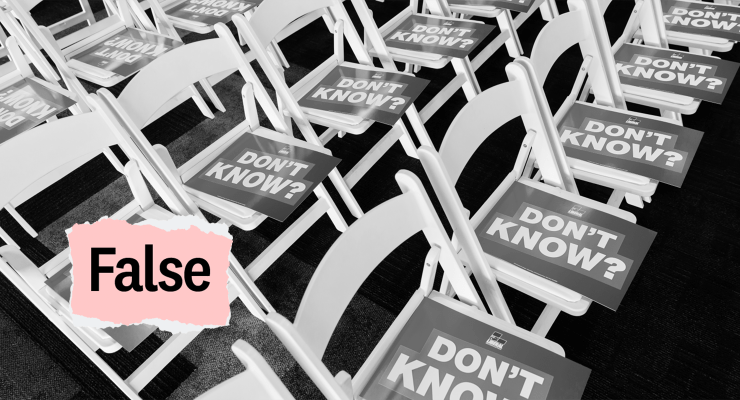
What was claimed
Ticks in the No box may be counted as a Yes vote in the Voice referendum.
Our verdict
False. There will be only one box on the ballot paper, with voters instructed to write either Yes or No.
Social media posts claim there will be two boxes on the Voice referendum ballot paper and ticks in the No box may be counted as a Yes vote. This is false. The Australian Electoral Commission (AEC) and an expert told AAP FactCheck the ballot paper will have only one box, as has been the case for referendums for decades.
Voters are instructed to write either Yes or No in the single box — as was the case in the 1999 referendum, when two questions were put to voters and each question had one box.
For voters who fail to follow instructions and instead place a tick or cross in the box, the tick may be counted as a Yes, but crosses are deemed informal due to the symbol’s ambiguity. These rules are included in the AEC’s ballot paper formality guidelines, which specifically refer to what happens when a tick or cross is used (from page 30).
The claim is made in a Facebook post (screenshot here) and is being shared or repeated, as seen here and elsewhere.
“In what appears to be some dirty last minute manipulation of due process, to increase the chances of a ‘yes’ result on the voice referendum, the Australian Electoral Commission will not accept any ‘X’ written on a ballot paper. It’ll only be counting ticks — even ticks in the “no” box may be counted as a ‘yes vote’,” the post states.
“To ensure your no vote is actually counted as a no vote, you’ll need to literally write ‘NO’ in English on the ballot paper, making this the first vote in Australian history in which voters are required to write out their response rather than just mark the relevant box as per usual.”
The claim a tick in the No box would be counted as a Yes is false, as is the claim this is the first time Australians are required to write their referendum response. There will be only one box on the ballot paper — not separate Yes and No boxes.
“Not different for this referendum — it has been one box per question for a long time,” an AEC representative told AAP FactCheck.
The AEC issued a statement on referendum voting instructions after “intense commentary online”, stating the social media claims were “factually incorrect”.
Kevin Bonham, an electoral analyst who addressed the accusations of “new rules” for referendum voting in an extensive blog, told AAP FactCheck the claims were untrue. He said the single box had been used in referendums for many decades.
“This has not been true in federal referendums any time recently,” Bonham said. “Yes and No boxes were used in referendums up to 1951, initially with Xs and later with 1s and 2s as in preferential voting.
“Preferential voting is counterintuitive for a referendum, resulting in the switch to writing Yes or No.”
Bonham believed people were confusing referendum voting with the marriage equality survey, which had two boxes.
“Each referendum question has had one box for that question for all federal referendums from 1965 onwards,” he said. “Two boxes were used for the 2017 marriage law postal survey, but it was a voluntary survey, not a referendum, and was not run by the AEC or under electoral law.
“In 1988 multiple questions appeared on the same ballot paper but with one box for each question, while in 1999 each question appeared on its own ballot paper.”
The AEC told AAP FactCheck it believed the vast majority of Australian voters would have the capacity to follow the instructions and cast a formal vote.
AAP FactCheck has debunked other claims about the use of ticks and crosses on the Voice referendum ballot paper.
The verdict
The claim ticks in the No box may be counted as a Yes vote in the Voice referendum is false. There will not be two boxes on the ballot paper. Voters are required to write either Yes or No in a single box.
The Australian Electoral Commission and an expert told AAP FactCheck one box per question has been the process followed for all referendums for decades.
If people fail to follow instructions and place a tick or cross in the box, the tick may be counted as a Yes, but crosses are deemed informal.
False — The claim is inaccurate.








Well that is entirely consistent with the no campaign which is based entirely on lies and racism as far as I can tell.
Lacking any sort of substance or credibility the NO people have to manufacture a sensation about anything that looks like they can beat it up into something, anything.
Multiple astroturf and misinformation campaigns have been running (for months) rampant on social media to confuse and muddy the water; accusations of offshore PRC influence, but one observes more local players or accounts, often also using offshore bots; McManus of the ACTU raised the issue months ago, action?
“You just can’t find any decent information or explanation about The Voice”, goes up the cry, whilst the same people manage to find every possible piece of misinformation and conspiracy, assume THAT’S correct information, and thus feel emboldened to proclaim biased reporting of the YES campaign is bullying people. It’s more like shrunken hearts, closed minds and vindictive racist attitudes are searching for validation.
I’m glad Crikey is publishing these fact-checking articles, even if I barely read them, as the myths busted are usually as transparent as the emperor’s new clothes. I hope they’re outside the paywall.